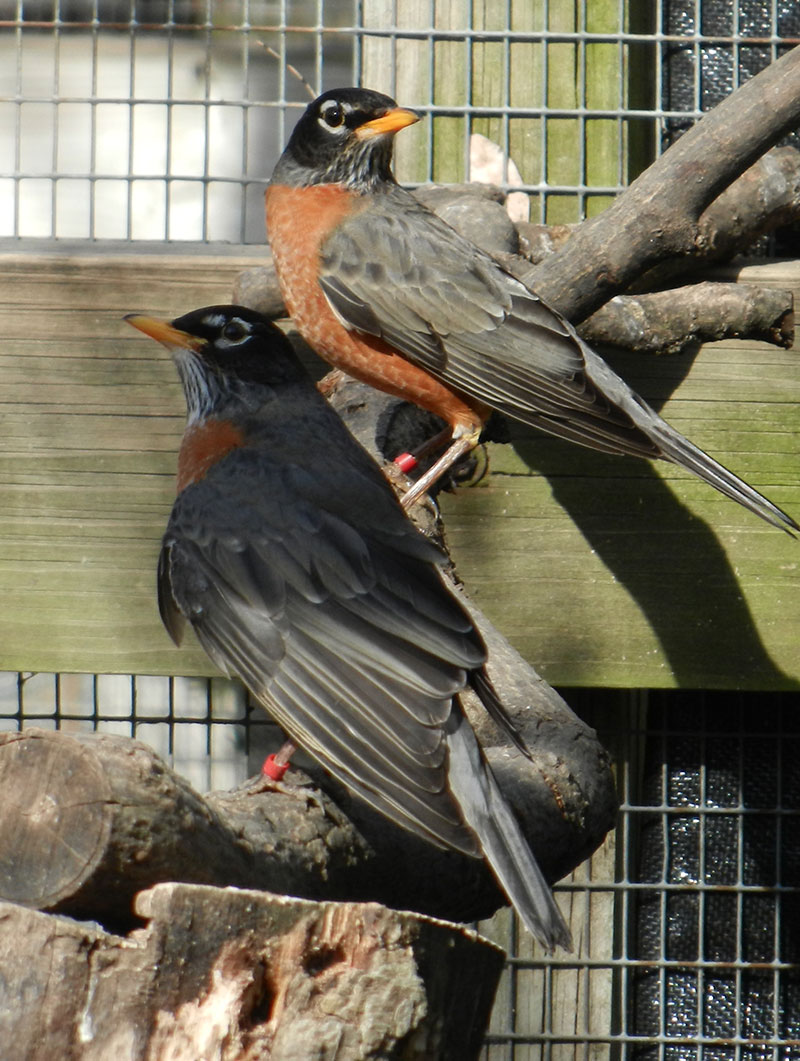American Robin
Turdus migratorius
Description:
The American robin is brown with a red breast and white lower belly. It has a black or grey head with white markings above and below its eyes and a yellow bill. Legs and feet are brown. The males are more brightly colored than the females.
Size:
American robins are 9-11 inches (22.8-27.9 cm) long with a wingspan of 12-16 inches (30.5-40.6 cm). An average bird weighs about 2.7 ounces (76.5 g). Males are slightly larger than females.
Adaptations:
- Robins will form groups to attack predators such as blue jays and snakes.
- American robins stand on the ground and use their vision to hunt. After scanning the ground for worm movement, the robin cocks its head to better focus on the worm, then will run over and grab the worm.
- A robin can easily recognize another robin by the characteristic bright red color of the feathers on its breast.
Diet:
In nature, the American robin eats invertebrate animals (such as worms, caterpillars, and grasshoppers), fruits, and berries. Because worms are easier to find in the morning, robins usually eat worms during the first part of the day, and switch to fruits in the afternoon. At Cosley Zoo, the robin is fed fruits and vegetables, bird seed, mealworms, and a complete insectivore diet.
Reproduction:
Robins build their nests in trees or shrubs to protect them from predators. The breeding season occurs between April and July, and females lay two or three clutches (groups) of light blue eggs during this period. Each clutch is made up of three to five eggs. Females incubate the eggs for about 14 days until they hatch. After hatching, the young birds leave the nest within two weeks.
Shelter and space needs:
American robins are found throughout North America. They live in areas which contain short grasses for foraging and trees or shrubs for nesting. In the winter, when the food supply decreases, most robins migrate south, as far as southern Texas or Florida.
Life expectancy:
On average, American robins live about 1-2 years in the wild. They have the potential to live up to 14 years, but this is extremely rare. Only about ¼ of young robins survive their first year of life.
Relationship with man:
American robins are an important part of the food web. Because they are so numerous, they are an important food source for predators such as hawks and snakes. They also help to control insect populations and disperse seeds by eating fruit. Robins are commonly seen in back yards, which provide a good location to forage for food. Because they spend so much time on our lawns, robins are susceptible to pesticide poisoning and can be a good indicator of pollution. Robins have long been considered a harbinger of spring.
Fun Facts:
- The American robin makes a call which is said to sound like the words “cheerily, cheer up, cheer up, cheerily, cheer up”.
- It’s true that the early bird gets the worm! Robins use their sight to visually hunt for worms, so they do most of their hunting in the morning, when there is good lighting and the worms are closest to the surface.
- A young robin can eat up to 14 feet of earthworms in one day!






